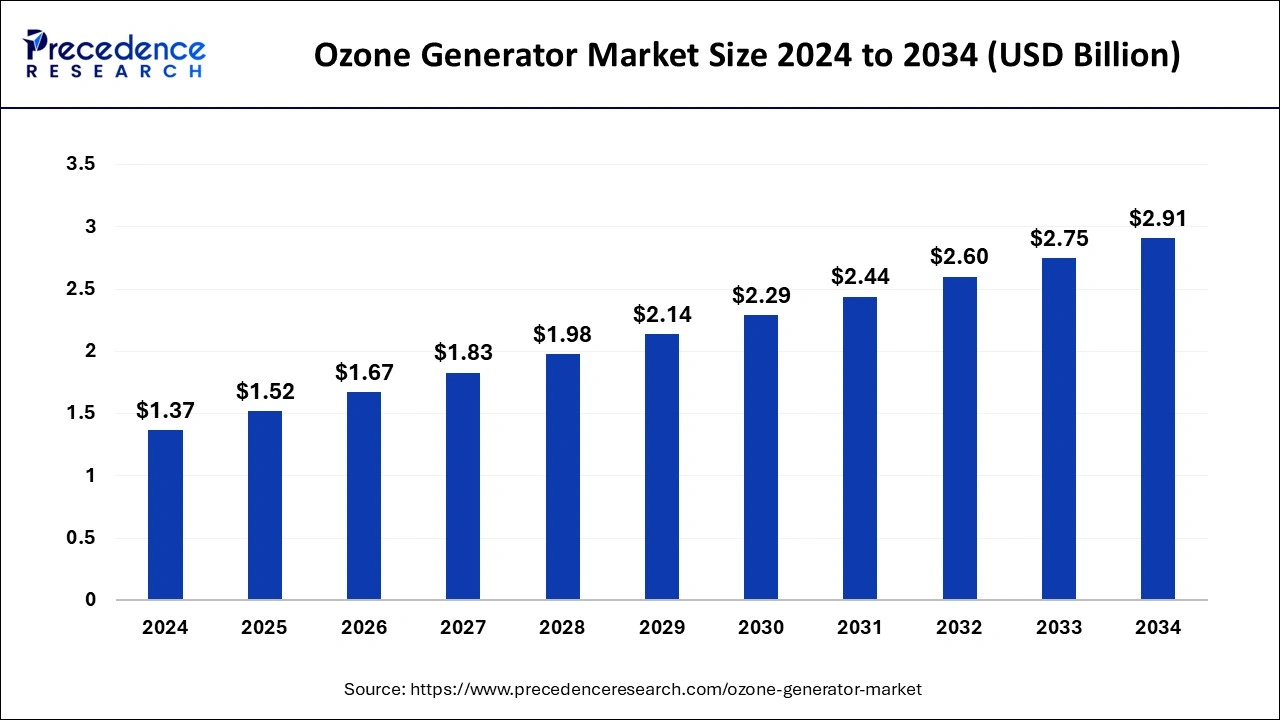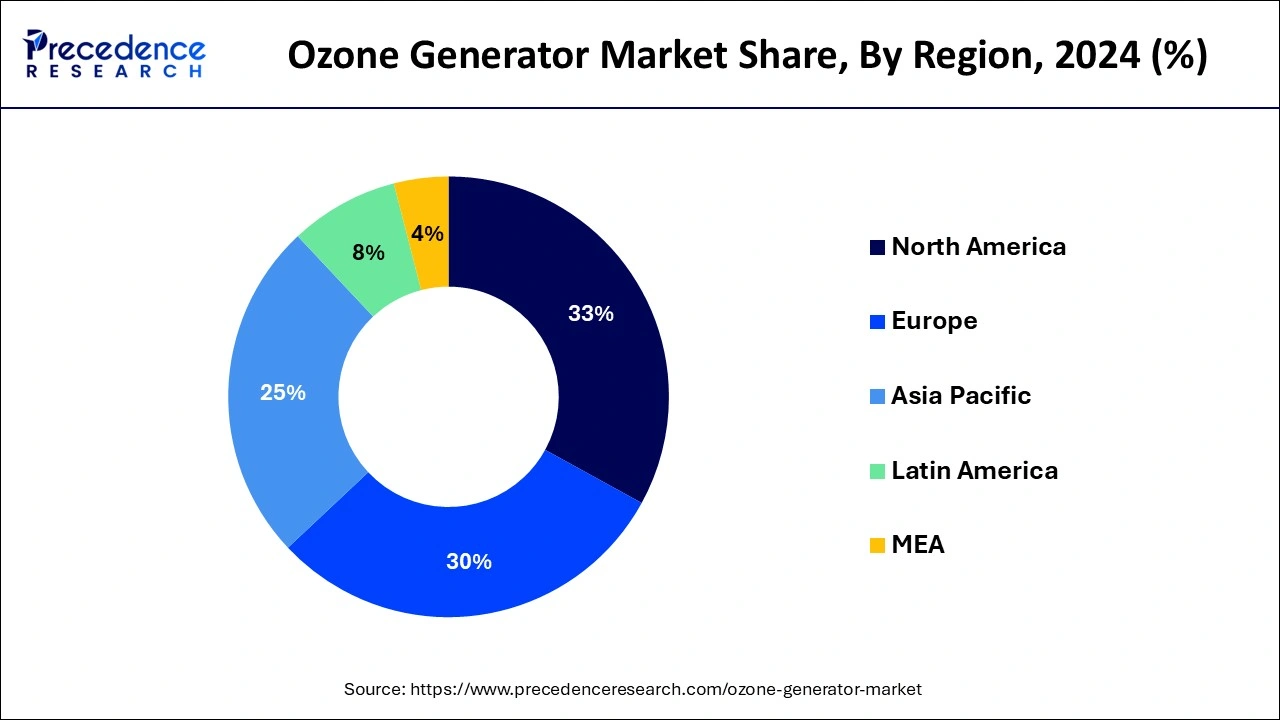December 2024
The global ozone generator market size is accounted at USD 1.52 billion in 2025 and is forecasted to hit around USD 2.91 billion by 2034, representing a CAGR of 7.82% from 2025 to 2034. The North America market size was estimated at USD 450 million in 2024 and is expanding at a CAGR of 7.87% during the forecast period. The market sizing and forecasts are revenue-based (USD Million/Billion), with 2024 as the base year.
The global ozone generator market size accounted for USD 1.37 billion in 2024 and is predicted to increase from USD 1.52 billion in 2025 to approximately USD 2.91 billion by 2034, expanding at a CAGR of 7.82% from 2025 to 2034.

The U.S. ozone generator market size was evaluated at USD 302.04 billion in 2024 and is projected to be worth around USD 671.63 billion by 2034, growing at a CAGR of 8.32% from 2025 to 2034.

On the other hand, North America commands a major share of the ozone generator market. This dominance is attributed to the region's strong focus on wastewater treatment and the demand for air treatment systems to address issues such as pungent odors, mold elimination, and smoke odor removal. The U.S. took a significant step by introducing a new Public-Private Partnership (PPP) law, aimed at stimulating investments in domestic water purification plant upgrades and new constructions. This legislative initiative is expected to positively impact the ozone generator market over the forecast period.
Asia-Pacific is poised for rapid growth in the ozone generator market due to escalating industrialization, increasing water and air pollution concerns, and stringent environmental regulations. The region's booming population and expanding industries drive the demand for efficient water and air treatment solutions. Additionally, growing awareness of the benefits of ozone over traditional disinfection methods contributes to market acceleration. As governments prioritize environmental sustainability, the adoption of ozone generators for diverse applications is expected to surge, making Asia-Pacific a key growth hub in the global ozone generator market.

Meanwhile, Europe is experiencing notable growth in the ozone generator market due to stringent environmental regulations, increasing awareness of water and air quality, and a growing emphasis on sustainable practices. The region's commitment to reducing chemical disinfectants and the rising demand for eco-friendly water treatment solutions contribute to the expanding market. Ozone generators, recognized for their effectiveness and environmentally friendly nature, align with these trends, driving their adoption across various industries and applications. As Europe prioritizes green technologies, the ozone generator market is witnessing significant and sustained growth in the region.
An ozone generator is a device designed to produce ozone gas; a potent compound composed of three oxygen atoms. This gas is renowned for its efficacy in eliminating odors, bacteria, viruses, and other contaminants in both air and water. The generator operates by employing ultraviolet light or corona discharge to break down oxygen molecules (O2) and create ozone (O3). Once released into a designated space, ozone reacts with and neutralizes pollutants, effectively purifying the air or water. Ozone generators find applications across diverse industries, including water treatment, air purification, and food processing. However, careful handling is essential, necessitating proper ventilation and adherence to safety guidelines, as elevated ozone concentrations can pose potential risks to both humans and pets.
| Report Coverage | Details |
| Growth Rate from 2025 to 2034 | CAGR of 7.82% |
| Market Size in 2025 | USD 1.52 Billion |
| Market Size by 2034 | USD 2.91 Billion |
| Base Year | 2024 |
| Forecast Period | 2025 to 2034 |
| Segments Covered | Technology, End-use, and Application |
| Regions Covered | North America, Europe, Asia-Pacific, Latin America, and Middle East & Africa |
An alternative to chlorine for water disinfection
While chemical methods, particularly chlorination, have been traditional for water disinfection, they bring significant health and environmental risks. It is now widely understood that chlorinated water may still contain water-borne pathogens, some of which are not regulated and can cause human diseases. The US Council of Environmental Quality warns that over 93% of people consuming chlorinated water face potential cancer risks. Additionally, chlorination results in the creation of harmful byproducts like trihalomethanes. In contrast, ozone generators are gaining traction as a safer alternative. Ozone effectively addresses water disinfection without the associated drawbacks of chlorine.
Ozone proves to be cost-effective, eliminating the need for transportation and storage. The rising awareness of these advantages over chlorine, coupled with stringent regulations from environmental agencies like the EPA monitoring disinfection byproduct limits, is expected to drive the increasing adoption of ozone generators in the future.
Limited ozone half-life
The limited ozone half-life poses a significant restraint on the market demand for ozone generators. Ozone has a relatively short lifespan, especially under ambient conditions, making on-site generation imperative for immediate use. This characteristic limit the feasibility of transporting and storing ozone over long distances, impacting applications where instantaneous treatment is not feasible. The need for real-time generation may pose logistical challenges for industries and municipalities that require consistent and continuous water or air treatment.
Moreover, the short half-life of ozone necessitates careful planning and coordination to optimize its effectiveness. This constraint can influence decision-makers who may seek alternatives with more extended stability for applications where a sustained disinfection effect is crucial. As the ozone generator market continues to evolve, addressing the challenge of limited ozone half-life through technological innovations and strategic planning will be pivotal for sustaining and expanding its market demand.
Investments by developed countries in emerging economies
The lack of access to safe drinking water, is primarily due to insufficient capital for municipal and industrial water treatment. In response to this pressing challenge, several countries are embracing the idea of a joint business model to spur market growth and public benefit. In this model, nations or private investors invest in the development of wastewater treatment systems and ozone generators across different countries. By adopting a joint business approach, countries can pool resources and expertise to address water treatment inadequacies on a larger scale.
This collaborative effort not only promotes market growth for ozone generators but also contributes to the broader goal of improving global access to safe drinking water. The joint business model serves as a strategic solution to overcome financial barriers and enhance the deployment of ozone-based water treatment technologies, ultimately working towards the WHO's vision of ensuring universal access to clean and safe water.
The corona discharge segment dominated the ozone generator market in 2024; the segment is observed to continue the trend throughout the forecast period. In the ozone generator market, the corona discharge segment refers to a technology that utilizes electrical discharges to generate ozone. This method involves passing dry air or oxygen through a corona discharge, leading to the creation of ozone for various applications like water treatment and air purification. A notable trend in this segment involves continuous advancements in corona discharge technology, enhancing efficiency and reliability. Ongoing research and development are focused on optimizing the performance of corona discharge ozone generators, aligning with the market's demand for effective and sustainable ozone generation solutions.
The cold plasma segment is expected to grow at a significant rate throughout the forecast period. In the ozone generator market, the cold plasma segment refers to the technology that utilizes low-temperature plasma to generate ozone. This advanced method offers advantages such as enhanced efficiency, reduced energy consumption, and minimized harmful byproducts. Recent trends in the ozone generator market indicate a growing preference for cold plasma technology due to its eco-friendly profile and superior disinfection capabilities. As industries prioritize sustainable solutions, the cold plasma segment is witnessing increased adoption, reflecting a broader shift towards environmentally conscious and effective ozone generation technologies.
The municipal segment is observed to hold the dominating share of the ozone generator market during the forecast period. In the ozone generator market, the municipal segment refers to the use of ozone generators in the treatment of municipal water and wastewater. Municipalities worldwide are increasingly adopting ozone generators for water disinfection due to their efficiency in removing contaminants and pathogens. The trend indicates a shift towards sustainable and environmentally friendly water treatment solutions. Ozone's effectiveness in eliminating pollutants makes it a preferred choice for municipal applications, aligning with the global emphasis on enhancing water quality and ensuring safe drinking water for urban populations.
The commercial segment is expected to generate a notable market share in the market. In the ozone generator market's commercial segment, the end-use pertains to applications within commercial establishments. This includes hotels, restaurants, offices, and other business spaces. A key trend in this sector involves the increasing adoption of ozone generators for air and water purification. As businesses prioritize creating healthier and safer environments for employees and customers, the demand for ozone generators in commercial settings is on the rise. Ozone's efficacy in eliminating contaminants aligns with the growing emphasis on sustainability and health in commercial spaces, driving the market's upward trajectory in this segment.
The wastewater treatment segment is observed to hold the dominating share of the ozone generator market during the forecast period. The wastewater treatment segment in the ozone generator market involves using ozone for efficient purification of wastewater. Ozone's strong oxidizing properties make it effective in breaking down pollutants and contaminants in water. A notable trend in this segment is the increasing adoption of ozone generators for wastewater treatment due to their eco-friendly nature and superior disinfection capabilities. Industries and municipalities are leveraging ozone technology to meet stringent water quality standards and address environmental concerns, driving the growth of the wastewater treatment segment within the ozone generator market.
The air treatment segment is expected to generate a notable market share in the market. In the ozone generator market, the air treatment segment involves the use of ozone for purifying and disinfecting air. This application addresses various industries, commercial spaces, and healthcare settings. A notable trend in this segment is the increasing adoption of ozone generators for air purification, driven by the rising awareness of indoor air quality. Ozone's effectiveness in neutralizing odors, eliminating airborne contaminants, and disinfecting spaces has led to a growing demand for air treatment solutions, making it a significant and expanding segment within the ozone generator market.
By Technology
By End-use
By Application
By Geography
For inquiries regarding discounts, bulk purchases, or customization requests, please contact us at sales@precedenceresearch.com
No cookie-cutter, only authentic analysis – take the 1st step to become a Precedence Research client
December 2024
September 2024
October 2024
November 2024